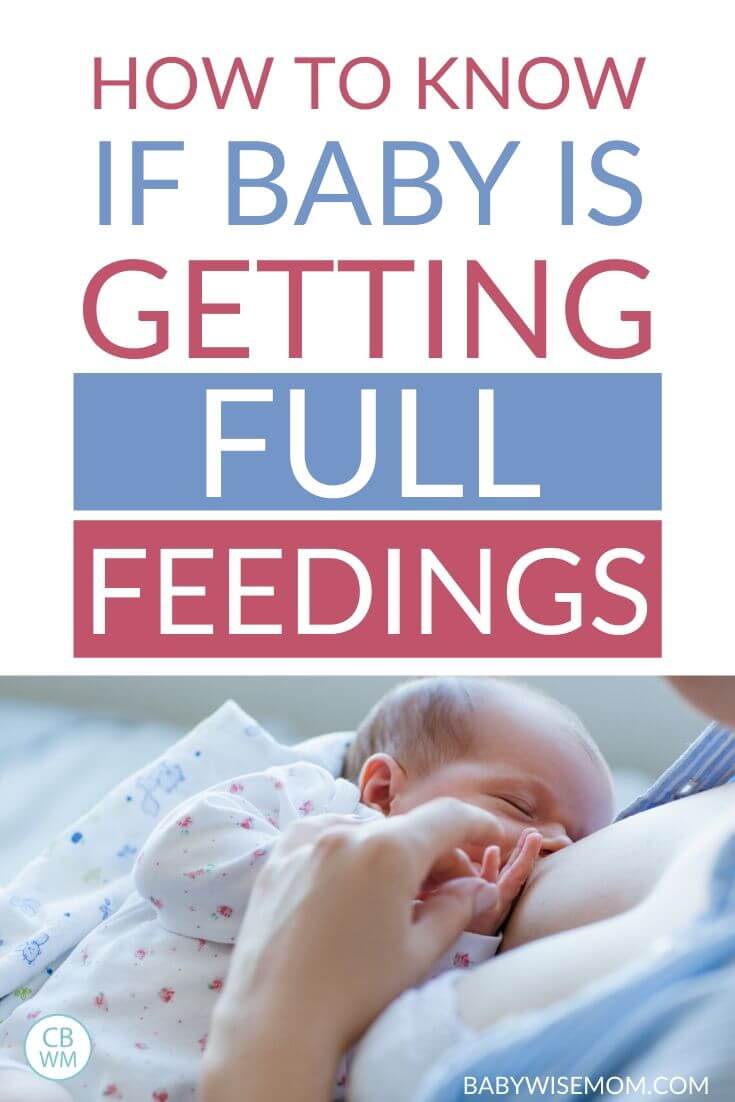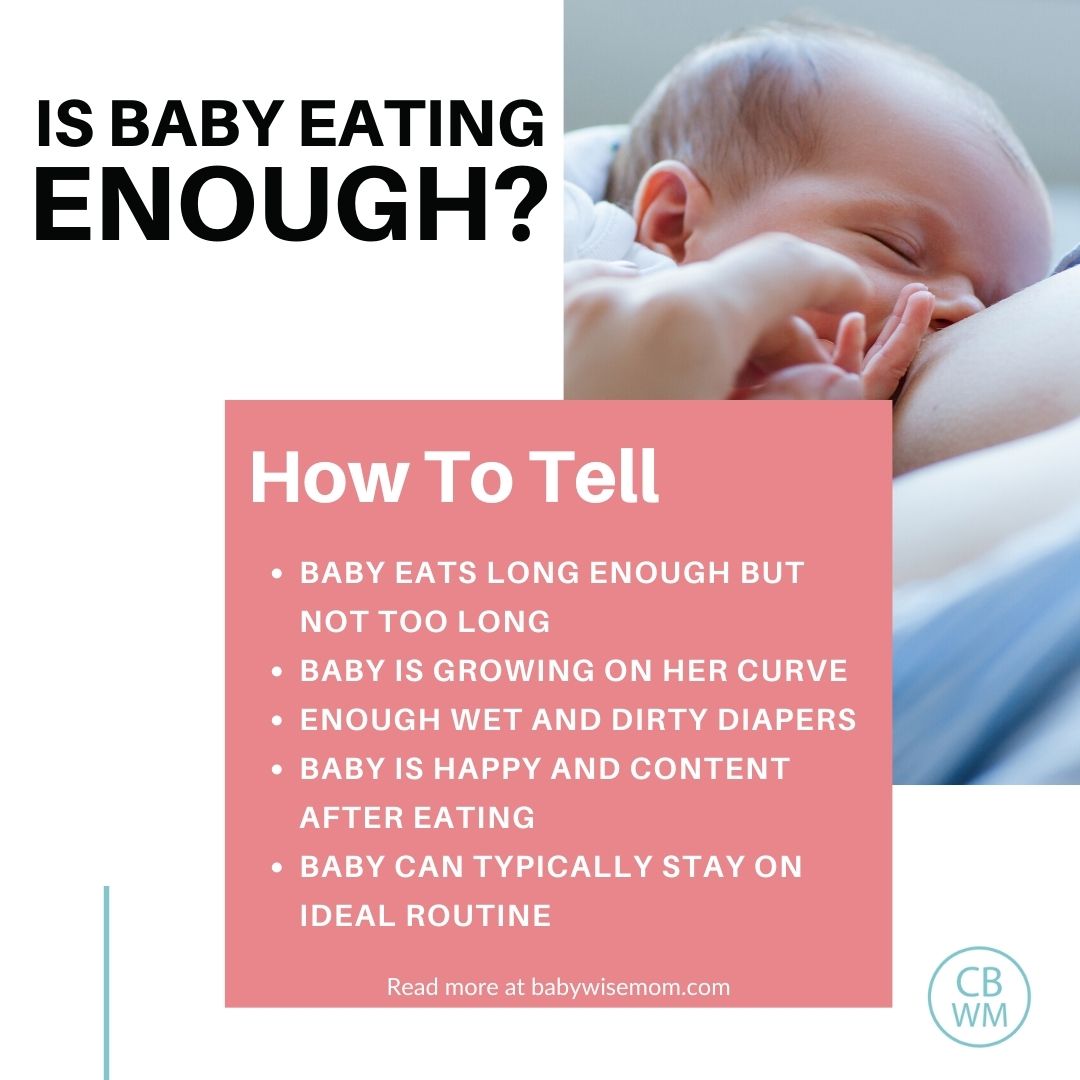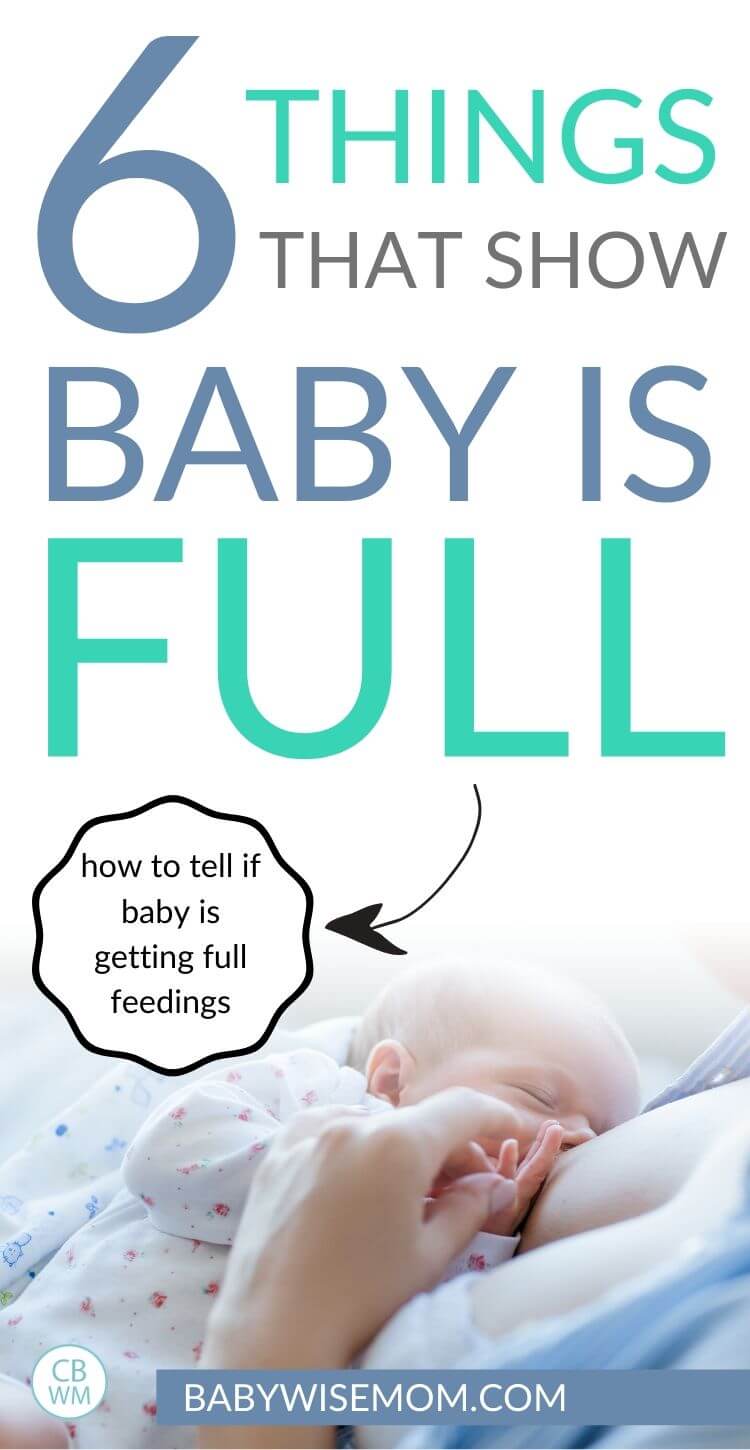An important element to a successful baby routine is making sure baby gets a full feeding. Read to get a list of 6 items to watch for and monitor.

When you have a new baby, you want to make sure you are doing everything you can to take care of that sweet little one.
A difficult aspect for every new parent to figure out is if baby is getting a full feeding or not. With time, you come to know your baby and know when baby is full, but even your second, third, and fourth babies will require some learning curve as you get to know each individual baby.
There are some common things to watch out for to know if baby is done eating or not. Let’s discuss 6 ways you can tell baby is full and has had a full feeding.
Post Contents
- Baby is Eating the Correct Length of Time
- How Long is the Ideal Feeding Length
- Signs Baby is Done Eating
- Baby is Growing Well
- Baby’s Diaper Output is Correct
- Baby is Happy and Content After Feeding
- Baby is Able to Stay Close to Projected Sleep and Feeding Schedule
- Have Babywise Success!
- Thank you!
- Baby Has a Good Latch
- Conclusion
- Related Posts
- Reader Questions
Baby is Eating the Correct Length of Time
Your baby needs to be eating the correct length of time to get a full feeding in. Baby cannot be eating too quickly, and conversely, he cannot be eating too slowly.
If baby takes too long to eat, it typically means that baby is dozing while feeding. You need to work to keep your baby awake to make sure baby is getting enough to eat at each feeding.
Babies can look like they are sucking even while they are sleeping. With my first baby, I thought he was taking an hour to eat for each breastfeeding session. I later figured out he was eating, catnapping, and eating some more, all while looking like he was just slowly eating.
See these posts for help with feeding sleepy babies:
- How to Nurse a Sleepy Newborn
- Sleepy Newborns: Work for 10 Minutes
- Nursing A Newborn: Keep Baby Awake!
How Long is the Ideal Feeding Length
This is a tricky question to answer because every baby is different.
In general, most babies can get a full feeding in 20-30 minutes. That is a good length of time to aim for.
If you are making sure your baby is awake for the duration of the feeding, absolutely let that feeding go to 40 minutes if baby needs it.
If your baby is a super fast eater, do not feel the need to push it to 20 minutes. That can lead to a lot of frustration on baby’s part.
My second baby was a super, super fast nurser. She started out around 20 minutes, but quickly got faster.
Every one of my four babies had a different length of “ideal” feeding time. This is an element you will need to get to know your individual baby on. Aiming for 20-30 minutes is a safe length of time to focus on until you know your baby.
Also, babies to tend to get faster as they get older and bigger.
>>>Read: Feeding a Newborn: How Long is a Feed
Signs Baby is Done Eating
How do you know your baby is done nursing or done eating from the bottle? Here are some common things to look for:
- Baby unlatches and won’t stay latched if reattached
- Baby opens up his hands and his body relaxes
- Baby turns his head from the milk source
- The breasts feel empty or the bottle is empty (or nearly empty if you don’t know what baby typically eats yet)
- Baby is easily distracted
See the list of signs your little one is full from birth to 24 months old from the CDC here.
Baby is Growing Well
While babies will grow to different sizes based on genetics, you typically want your baby to follow her own curve. She should get bigger, and she should get bigger at a consistent rate.
Your baby should be back to her birth weight by 2 weeks old.
Your baby should typically gain about 5-9 ounces each week.
Work closely with your baby’s doctor on this. Your baby’s doctor will be able to examine your baby and see if the growth happening seems to be normal for her or if it is off.
Also, keep in mind that growth spurts will have a big impact on a leap in size and weight. Your baby might grow less one week but jump up a lot in a growth spurt. Remember, growth spurts typically happen every 3-4 weeks.
>>>Read: Baby Growth Spurts: Everything You Need To Know
Baby’s Diaper Output is Correct
A good way to monitor baby’s growth from home is to monitor diaper output.
Once your milk is in, you can expect at least 5-6 wet diapers a day. It can be more than that.
Your baby should also have a consistent pooping pattern. How often should baby poop? There can be great variance among experts on this. It can be once every few days. It can be 4 times a day.
My babies were all different. Your baby will get into a pattern. I recommend taking notes so you know what is normal and what isn’t for your individual baby.
Take note that it is normal for there to be less poop during a growth spurt.
>>>Track baby’s feedings and daily schedule with my Chronicles of a Babywise Mom Log eBook<<<
Baby is Happy and Content After Feeding
When your baby is done eating, he should be happy and content. He should be relaxed and at ease.
During his waketime length that follows a feeding, he should have energy and be as alert as can be expected for his age (newborns are very sleepy). He should not be lethargic.
As your baby gets older, he should be meeting his milestones in the normal range for meeting them.
There are always variances to milestones, but if your baby is not meeting any on time, bring it up with your pediatrician at your well-child checks just to be sure it is checked out.

Baby is Able to Stay Close to Projected Sleep and Feeding Schedule
If your baby is getting a full feeding, then she should be able to take a solid nap and make it to her next scheduled feeding time.
If you are making sure your baby is getting enough feedings in each day, she should be able to take a nap long enough to keep her on schedule.
There are of course things that can come up that will prevent her from staying on her feeding schedule. Growth spurts happen. You might not be timing her naps correctly. She might not know how to sleep independently.
If your baby is not able to make it to her next feeding consistently and she isn’t having a growth spurt, one consideration on your list of troubleshooting is if she is getting full feedings or not.
>>>Read: The Complete Guide to Troubleshooting Short Baby Naps
If she is not making it to her next feeding or not sleeping well and you see other problems with the things listed in this post, take a strong look at her feedings. If her diaper output is low, her growth is slow, and she is waking often, you likely have a feeding issue.
Baby Has a Good Latch
If your baby does not have an adequate latch, it can lead to feeding issues. This can happen by simply having a lazy latch but can also happen because of a tongue tie or lip tie.
Conclusion
While you might feel initially confused over if your baby is getting a full feeding or not, this list and your own experience as you get to know your baby can help you know when baby is full and done eating.
Related Posts
- Your Babywise Baby: First Year Overview
- How To Increase Your Milk Supply FAST
- Optimal Waketime Lengths
- How to Successfully Do “On Becoming Babywise”
- Nursing Woes {Baby Playing While Breastfeeding}

Reader Questions
juls1974 said…
Hello, there! I’m new to this blog and to Babywise. I have a 4 week old and have TONS of questions about his sleeping/eating schedule. I will start with a basic one (forgive me if it’s too basic): what defines a “full feeding” when nursing? Is it a length of time or just until the baby no longer wants anymore? I’ve been searching through the blog but haven’t found the answer yet.
Babywise Mom said…
juls1974, A full feeding is a feeding where baby takes all he needs to be full. This means you don’t let him nurse for a few mintutes then fall asleep, wake up an hour later and eat a few more minutes, etc. You can tell if there is a full feeding if baby is happy afterward and if he can make it to the next feeding time.You can’t tell just by time since some take longer times to eat than others, and they themselves change how long they take to eat over time. It is hard to tell at first, but you will get it. For a four week old, expect about 30 minutes for a full feeding, though some will take longer and some shorter.


